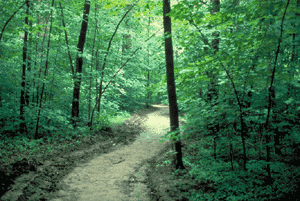EARLY EMIGRANT TRAILS

by Marcus Lewis
Trails made by wild animals in search of food or drink existed upon the earth long before the appearance of man, changing very slowly as local conditions were altered by erosion, climatic shifts or other causes.
People began using these trails because they led to salt licks, and to other places where water, food, and materials for clothing could be obtained.
There was far more travel among the Indians in their early undisturbed condition than is usually supposed. There are well-authenticated cases of Indians having gone on visits to distant tribes, covering from 1000 to 2000 miles. A friendly visitor with a new sacred or social dance was always welcome in any Indian village, and great pains were usually taken to learn it.
Indians covered our continent with a network of trails over which they ran long distances with great speed and endurance. These trails followed the lines of least resistance, always a most valuable feature in transportation or travel. In the selection of trails they avoided rough, stony ground and dense undergrowth.
The great settlements of earlier peoples always have been in the richer valleys, or on certain sites possessing natural advantages; therefore the paths found and used by one people were, through a large portion of their length, followed by their successors even though the terminal towns or points of interest may have shifted somewhat, and some sections of them had become worn down below the original natural surface of the ground.
In later years, when the white man came, either on foot or on horseback, and when the Indians would permit, they used the same trails, and many portions of them were later followed successively by the white man's wagon roads so that several of the great State or National turnpikes and highways follow substantially the paths of the ancient animals and their later successors, the white settlers.
With the opening of Government lands to the west of the Alleghenies, the former narrow Indian trails had to be widened to allow the passage of the packhorse, and later, the wagon. Thousands of shorter trails were first widened for local needs; then came the longer connecting early roads, among the first of which was the one across southern New York; the one across southern Pennsylvania; the one from Philadelphia through Shenandoah valley to the south and southwest, and its branch through the Cumberland Gap to Kentucky, Ohio, and the northwest.
This article is abstracted from a speech delivered before the National Genealogical Society, Washington, D. C., on February 6, 1932
